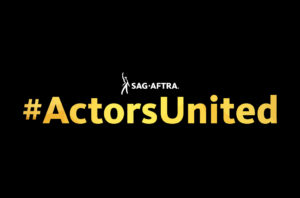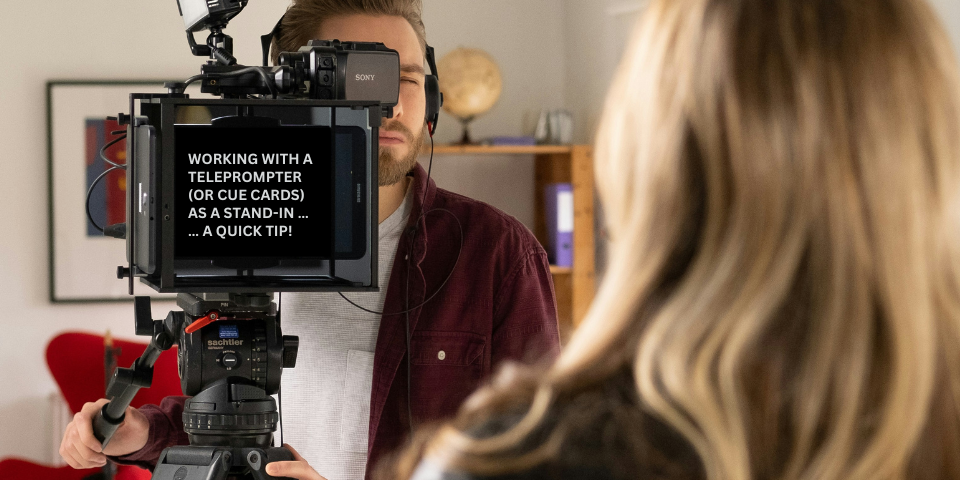On July 4, 2017, SAG-AFTRA announced it had reached a tentative deal with the Alliance of Motion Picture and Television Producers (AMPTP) over the collective bargaining agreement that governs the work of SAG-AFTRA’s members in “theatrical” work — i.e., movies and dramatic television.

Before reaching a deal with the AMPTP on July 4, 2017, SAG-AFTRA created the #ActorsUnited hashtag upon release of information about its board’s unanimous vote to authorize a strike authorization referendum
As reported last week on Stand-In Central, their three-year contract was set to expire on June 30, 2017. Negotiations went on daily past the expiration date, extending the contract one day at a time in order for the parties to reach an agreement. The negotiations went on under the threat of SAG-AFTRA sending a strike authorization vote to its members, presumably because of “outrageous rollbacks” presented to SAG-AFTRA by the AMPTP.
The operative word in the opening passage is “tentative.” The agreement that SAG-AFTRA and the AMPTP forged has not yet been ratified, so it is not yet in effect.
So, if you’re a SAG-AFTRA stand-in who works on movies and dramatic television, you may be wondering, “Now what?” Here are some answers to your questions.
What Contract Is in Effect
Note:
You can read the basic agreement plus the memoranda of agreement that contain updates to the basic agreement on the SAG-AFTRA website. At press time, the terms of the 2017 tentative agreement are not yet available to view.
The SAG-AFTRA Constitution dictates the next steps for approval of (national) collective bargaining agreements. It reads in Article XI (B):
All multi-employer collective bargaining agreements that are national in scope shall be approved by the National Board and submitted for ratification by the members affected thereby. Such ratification may be made either (a) by majority vote of the members voting in a referendum conducted by mail or electronic means under policies and procedures established by the National Board, or (b) by majority vote of the members voting in meetings held in accordance with policies and procedures established by the National Board.
So, given the above passage, in order for the tentative deal forged between SAG-AFTRA and the AMPTP to go into effect, first the SAG-AFTRA National Board of Directors must approve it. According to SAG-AFTRA’s press release, the board will be presented with the tentative agreement on July 15, 2017.
If and when the SAG-AFTRA National Board approves the tentative agreement, the tentative agreement will be presented to SAG-AFTRA members for vote on whether or not to ratify the tentative agreement. SAG-AFTRA members who work under the Theatrical contract will have the opportunity to vote “yes” to ratify the tentative agreement or “no” not to ratify the agreement.
- If a majority of SAG-AFTRA members who work under the Theatrical contract vote to ratify the tentative agreement — meaning, if above 50% of those casting votes vote “yes” to ratify the tentative agreement — the tentative agreement will go into effect at some point soon after such ratification. It will in effect become the new collective bargaining agreement expiring June 30, 2020.
- If, however, less than 50% vote “yes” to ratify the tentative agreement — or if more than 50% vote “no” not to ratify the agreement — then the tentative agreement would not go into effect. Presumably, SAG-AFTRA and the AMPTP would renew negotiations in order to forge a new tentative agreement that would satisfy the SAG-AFTRA National Board of Directors and SAG-AFTRA members. Presumably the contract that expired on June 30, 2017, would continue in effect.
All in all, while you await potential approval of the tentative agreement by the SAG-AFTRA Board of Directors and potential ratification of it by SAG-AFTRA members, the agreement that expired June 30, 2017, is still in effect when you stand in on films as well as dramatic television. The tentative agreement will not go into effect unless SAG-AFTRA members ratify it by majority vote.
Voting on the Tentative Agreement
If you are a SAG-AFTRA member who works under Theatrical contracts, assuming that the SAG-AFTRA Board of Directors approves the tentative agreement, you will have an opportunity to vote whether to ratify or not ratify the agreement.
While SAG-AFTRA has released a summary of the gains it made in coming to the 2017 tentative agreement, what SAG-AFTRA has not yet released are its losses in bargaining with the AMPTP. Stand-ins are not yet aware of what they may have lost in the 2017 tentative agreement, so they are not yet informed enough to blindly follow SAG-AFTRA’s guidance on how to vote on it. For example, if the union gave away something important to stand-ins, would you vote to ratify the tentative agreement? Specific terms are not yet available about the tentative agreement, so it is hard to develop an impression of SAG-AFTRA’s success in bargaining. (Presumably, the terms would not be available until after the Board of Directors approves the tentative agreement, so the terms will probably not be available until on or after July 15, 2017.)
In the past, SAG-AFTRA has promoted to its members to vote “yes” to ratify its negotiated agreements. As explained in last week’s post about strike authorization votes, whether you vote “yes” or “no” can depend on whether you are voting in consideration of yourself or of the whole of affected members. Furthermore, others may be happy with their gains in a tentative agreement, but you may be unhappy with your gains or losses in the tentative agreement. Will others vote not to ratify in light of stand-ins’ unhappiness, or will they just consider themselves and vote to ratify? Should you vote to ratify if you are unhappy about stand-in gains and losses, or should you consider others’ happiness with their gains and vote to ratify?
Once the union releases a referendum on the tentative Theatrical agreement, it would help you as a stand-in that you take time to read the document and its terms carefully when considering your vote. While the union may promote a vote of yes to ratify the tentative agreement and guide the majority voting toward ratification, a strong and vocal turnout voting no is necessary to overcome any SAG-AFTRA effort to persuade a “yes” vote.
If history is any guide, “no” votes need to turn out rather than not participate in voting if they want to have an effect on the future of the Theatrical agreement. And they must turn out strongly. In the 2014 ratification vote, only 16% of approximately 137,000 members actually voted — roughly 21,920 members. So, just 16% of members had an influence on 137,000 members who work under the Theatrical contract. Of those 21,920 members, 92.12% voted “yes” to ratify (approximately 20,193 members), while 7.88% voted “no” on ratification (approximately 1,727 members). So more truthfully, only 10,961 SAG-AFTRA members constituted a majority, whose yes votes inevitably ratified the 2014 tentative agreement that bound 137,000 SAG-AFTRA members to those terms. That’s just 8% of members having an impact on 137,000 members.
A more “brutal” interpretation is that it took not 10,961 SAG-AFTRA members to constitute a majority but instead 1,728 members — one more “yes” vote than the 1,727 “no” votes. That would means that 1.3% of SAG-AFTRA members inevitably ratified the 2014 tentative agreement that bound 137,000 SAG-AFTRA members to those terms.
To tip that balance, approximately 10,961 of the 16% who voted needed to vote “no” rather than “yes” in order not to ratify 2014’s tentative agreement. Probably more accurately, 20,194 members had to vote “no” to overcome the 92.12% of voters who turned out to vote “yes” to ratify. That would imply that 18,467 more members would have had to turn out to vote “no” than the 1,727 who did in 2014.
So, if you dislike the terms of the 2017 tentative agreement, in order for your vote to overcome SAG-AFTRA’s presumed efforts to persuade a “yes” vote, you may have to promote your views and adamantly encourage others to vote “no” rather than simply not cast a ballot. And you may have to get approximately 21,000 other members to vote “no” with you to overcome a “yes” majority if 2014 is a guide.
Retroactive Payments
In the past, when a Theatrical collective bargaining agreement expired, it continued to be in effect until the new tentative agreement was ratified. This meant, for example, that the pay rates for stand-ins after June 30th continued to be in effect on July 1st and onward. The pay rates for stand-ins increased only after SAG-AFTRA members ratified the tentative agreement that increased stand-ins’ pay rates.
However, the terms of the newly ratified agreement were retroactive to the expiration date, meaning that stand-ins who worked under the contracts after their expiration — say, June 30th — until the date they took effect — say, late August — subsequently received “retroactive payments” for their work between June 30th and late August. Retroactive payments are relatively small checks that correct the underpayment of stand-ins during the period after the expiration of the contract and before the ratification of the tentative agreement.
For example, the Theatrical agreement in 2014 expired on June 30th and was ratified by SAG-AFTRA members on August 22nd. If you worked as a stand-in on films or SAG dramatic television from July 1 through August 22, you received $163 for 8 hours of work — which was the going rate when the contract expired on June 30th. After August 22, you enjoyed the new agreement’s 5% raise for stand-ins, earning from that point onward $171/8. You also eventually were mailed checks to compensate you for underpayment for stand-in work you did from July 1 through August 22. So, you were mailed a small check to correct your underpayment at $163/8, using the new rate of $171/8 as a guide.
In other words, if you worked one 8-hour day as a stand-in on, say, July 15th, you eventually received a check for $8 gross ($171 − $163).
Summary
With the tentative agreement between SAG-AFTRA and the AMPTP, stand-in work in July 2017 onward will continue under the terms of the collective bargaining agreement that expired on June 30, 2017. The tentative agreement dodged the union calling for a strike authorization from its members and a potential strike — at least for now. First, the union’s board of directors has to approve the tentative agreement, then its members have to ratify it. If ratified, the terms of the agreement kick in, which may mean that you may receive retroactive payments for your stand-in work on films and dramatic television performed on July 1st through the date of ratification.
Watch Stand-In Central’s Tips & Tricks Blog for updates on the details of the 2017 tentative Theatrical agreement and what those details mean for stand-ins.
Do you have any thoughts on the gains SAG-AFTRA made in the 2017 tentative Theatrical agreement? Share your opinions below!






Leave A Comment